Comments / Questions (1)
![]() Anja Bruun wrote:
Anja Bruun wrote:
Hej Jeg vil hære om jeg kan strikke den med Karisma Gran Mange tak for hjælpen 😏😏😏
27.05.2025 - 18:20DROPS Design answered:
Hej Anja, ja men da skal du strikke med 3 tråde DROPS Karisma for at få strikkefastheden til at stemme med opskriften. Hvis du vil strikke med 1 tråd Karisma kan du vælge imellem dem her: Cardigan - raglan - oppefra og ned - 21 masker
28.05.2025 - 07:47
Blue Bliss Cardigan#blueblisscardigan |
|
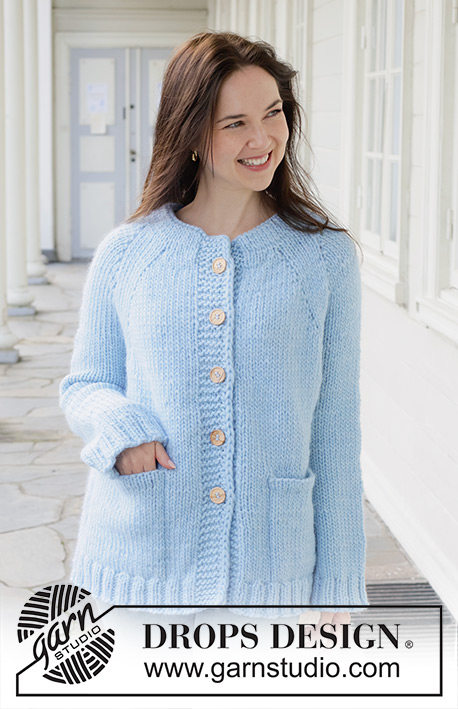 |
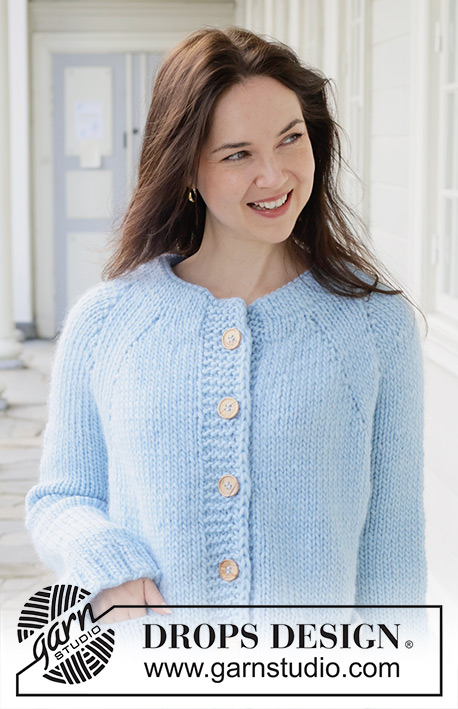 |
Knitted long oversized jacket in DROPS Snow. Piece is knitted top down in stockinette stitch with double neck edge, raglan, pockets and I-cord. Size XS – XXXL.
DROPS 259-37 |
|
|
---------------------------------------------------------- EXPLANATION FOR THE PATTERN: ---------------------------------------------------------- GARTER STITCH (when working back and forth): Knit on all rows, i.e. knit from right side and knit from wrong side. 1 ridge vertically = knit 2 rows. BAND WITH I-CORD: BEGINNING OF ROW: Work band as follows: Slip 1 stitch purlwise with strand in front of piece, knit 1 and work 5 stitches in garter stitch. END OF ROW: Work band as follows: Work until 7 stitches remain on row, work 5 stitches in garter stitch, slip 1 stitch purlwise with strand in front of piece, knit 1. Work the same way both from right side and wrong side. BUTTONHOLES: Decrease for buttonholes on right band (when garment is worn). Decrease from right side when 5 stitches remain on row as follows: ROW 1 (= right side): Make 1 yarn over, knit 2 together, knit 1, slip 1 stitch purlwise with strand in front of piece, knit 1. ROW 2 (= wrong side): Work band as before and knit yarn over to make a buttonhole. Decrease for first buttonhole on first row from right side after neck edge has been worked. Then decrease the next 4 buttonholes, approx. 9-9½-9½-10-10-10½ cm = 3½"-3⅝"-3⅝"-4"-4"-4⅛" apart. Place bottom buttonhole in the transition between stockinette stitch and rib. RAGLAN: Increase 1 stitch by making 1 yarn over as explained below: INCREASE 1 STITCH TOWARDS THE RIGHT BEFORE MARKER THREAD: Make a yarn over on right needle by placing the yarn around right needle from behind and forwards, on next row purl yarn over in front loop of stitch. Then work the new stitches in stockinette stitch. INCREASE 1 STITCH TOWARDS THE LEFT AFTER MARKER THREAD: Make a yarn over on right needle by placing the yarn around right needle in front of needle and then pull the yarn backwards, on next row purl yarn over in back loop of stitch. Then work the new stitches in stockinette stitch. INCREASE TIP: Increase 1 stitch by making 1 yarn over, on next row/round work yarn over twisted to avoid holes. DECREASE TIP: Decrease 1 stitch on each side of marker thread as follows: Work until 3 stitches remain before marker thread, knit 2 together, knit 2 (marker thread is between these 2 stitches), slip 1 stitch knitwise, knit 1, pass slipped stitch over stitch worked (= 2 stitches decreased). SLEEVE TIP: When picking up stitches mid under sleeve, there will be a small hole in the transition between stitches on body and sleeves. The holes can be closed by picking up the strand between two stitches - work this strand twisted together with the first stitch between body and sleeve so that the holes closes. ---------------------------------------------------------- START THE PIECE HERE: ---------------------------------------------------------- JACKET - SHORT OVERVIEW OF THE PIECE: In this pattern needles of different length have been used, begin with fitting length for number of stitches and switch as needed. Work neck edge and yoke back and forth on circular needle from mid front, work top down. When yoke is done, divide piece for body and sleeves. Work body downwards back and forth on circular needle while putting the sleeves aside. Then work sleeves downwards in the round on needle. Fold the neck edge double against the wrong side and fasten. NECK EDGE: Cast on 62-66-70-70-74-78 stitches on circular needle size 8 MM = US 11 with DROPS Snow. Switch to circular needle size 6 MM = US 10 (cast on on a larger needle to get an elastic cast-on edge). Purl 1 row from wrong side. Then work in stockinette stitch with 1 stitch in GARTER STITCH in each side - read explanation above. When neck edge measures 2-2-3-3-4-4 cm = ¾"-¾"-1⅛"-1⅛"-1½"-1½" and next row is worked from wrong side, work 2 rows in stockinette stitch while AT THE SAME TIME casting on 6 stitches for band at the end of each of these rows = 74-78-82-82-86-90 stitches. Knit 1 row from wrong side (= folding edge) but work the outermost 7 stitches in each side as BAND WITH I-CORD - read explanation above. Neck edge now measures approx. 4-4-5-5-6-6 cm = 1½"-1½"-2"-2"-2⅜"-2⅜" (= height of neck edge when it is folded double). Then work in stockinette stitch with 7 stitches band as before until neck edge measures 8-8-10-10-12-12 cm = 3⅛"-3⅛"-4"-4"-4¾"-4¾" from cast-on edge - finish with a row from wrong side. Insert a maker on the inside of band in one side of piece, measure piece from this marker. YOKE: Insert 4 marker threads in piece without working the stitches, insert marker threads between 2 stitches - NOTE: 3 stitches on each side of every marker thread (= 6 stitches in total) are called raglan stitches and is later used for increase for raglan before/after these 6 raglan stitches. Count 15-16-17-17-17-18 stitches (= left front piece), insert 1 marker thread before next stitch, count 14-14-14-14-16-16 stitches (= sleeve), insert 1 marker thread before next stitch, count 16-18-20-20-20-22 stitches (= back piece), insert 1 marker thread before next stitch, count 14-14-14-14-16-16 stitches (= sleeve), insert 1 marker thread before next stitch, 15-16-17-17-17-18 stitches remain on row after last marker thread (= front piece). Switch to circular needle size 8 MM = US 11 and work in stockinette stitch and band as before while AT THE SAME TIME increasing for RAGLAN and decreasing for BUTTONHOLES - read explanation above and work as follows: ROW 1 (= right side): Work stockinette stitch and bands as before and increase for raglan on each side of the 6 raglan stitches in every transition between front pieces/back piece and sleeves (= 8 stitches increased). ROW 2 (= wrong side): Work stockinette stitch and bands as before. Work 1st and 2nd ROW 6-3-6-7-12-11 times (= 12-6-12-14-24-22 rows have been worked) = 122-102-130-138-182-178 stitches on needle. Remember to follow the knitting gauge! Then work and increase as follows: ROW 1 (= right side): Work stockinette stitch and bands as before and increase for raglan on each side of the 6 raglan stitches in every transition between front pieces/back piece and sleeves (= 8 stitches increased). ROW 2 (= wrong side): Work stockinette stitch and bands as before. ROW 3 (= right side): Work stockinette stitch and bands as before and increase for raglan on front pieces and back piece, i.e. increase before 1st and 3rd marker thread and after 2nd and 4th marker thread - do not increase stitches on sleeves (= 4 stitches increased). ROW 4 (= wrong side): Work stockinette stitch and bands as before. Work 1st to 4th ROW 4-6-5-5-3-4 times (= 16-24-20-20-12-16 rows have been worked = you have increased 8-12-10-10-6-8 times on front pieces/back piece and 4-6-5-5-3-4 times on sleeves) = 170-174-190-198-218-226 stitches on needle. All increases for raglan are now done, you have increased 14-15-16-17-18-19 times in total have been done on front pieces/back piece and 10-9-11-12-15-15 times on sleeves = piece measures approx. 19-20-21-23-24-25 cm = 7½"-8"-8¼"-9"-9½"-9¾" from marker mid front. If the garment is shorter than this, work stockinette stitch and bands as before without increases until correct measurements. Now divide yoke for body and sleeves. DIVIDING FOR BODY AND SLEEVES: AT THE SAME TIME as next row is worked divide yoke for body and sleeves as follows: Work 32-33-35-36-39-41 stitches as before (= front piece), slip the next 28-28-32-34-38-38 stitches on a stitch holder for sleeve, cast on 6-8-8-10-10-12 new stitches on row (= in the side mid under sleeve), work 50-52-56-58-64-68 stitches in stockinette stitch (back piece), slip the next 28-28-32-34-38-38 stitches on a stitch holder for sleeve, cast on 6-8-8-10-10-12 new stitches on row (= in the side mid under sleeve) and work the last 32-33-35-36-39-41 stitches as before (= front piece). Finish body and sleeves separately. Now measure piece from here! BODY: = 126-134-142-150-162-174 stitches. Work back and forth from mid front over all stitches with stockinette stitch and band as before. Work until piece measures 16-17-17-16-15-16 cm = 6¼"-6¾"-6¾"-6¼"-6"-6¼" from division and next row is worked from right side (piece measures approx. 35-37-38-39-39-41 cm = 13¾"-14½"-15"-15¼"-15¼"-16⅛" from marker mid front). Leave the stitches on the needle and work 2 loose pocket inserts as explained below. POCKET INSERTS: Cast on 20-20-22-22-24-24 stitches on needle size 8 MM = US 11 with DROPS Snow. Work in stockinette stitch back and forth for 2½ cm = 1", knit 1 row from wrong side (= folding edge) and the slip the stitches on 1 thread. Knit another pocket insert the same way. BODY WITH POCKET OPENING: Now continue from the right side over body stitches while AT THE SAME TIME making a pocket opening as follows: Work 7 stitches band as before, 5-5-5-6-7-8 stitches in stockinette stitch, slip the next 20-20-22-22-24-24 stitches on 1 thread for pocket, slip the 20-20-22-22-24-24 stitches from one pocket insert on to left needle (with right side outwards), knit these 20-20-22-22-24-24 stitches, work 62-70-74-80-86-96 stitches in stockinette stitch, slip the next 20-20-22-22-24-24 stitches on 1 thread for pocket, slip the 20-20-22-22-24-24 stitches from the other pocket insert on to left needle (with right side outwards), knit these 20-20-22-22-24-24 stitches, work 5-5-5-6-7-8 stitches in stockinette stitch and 7 stitches band as before. Then work in stockinette stitch with band back and forth as before over all stitches until piece measures 53-55-57-58-59-61 cm = 21"-21⅝"-22½"-22¾"-23¼"-24" from marker mid front (piece measures approx. 18-18-19-19-20-20 cm = 7"-7"-7½"-7½"-8"-8" from pocket opening) – adjust so that next row is from right side. Leave the stitches on the needle and work the pockets as explained below. POCKETS: Slip the 20-20-22-22-24-24 stitches from thread on to circular needle size 8 MM = US 11 and work in stockinette stitch back and forth for 18-18-19-19-20-20 cm = 7"-7"-7½"-7½"-8"-8" (adjust so that pocket is the same length as to bottom of front piece) – finish after a row from wrong side and slip the stitches on 1 thread. When both pockets are done, slip pockets together with body as explained below. BODY CONTINUED: Work next row as follows from right side: 7 stitches band as before, 5-5-5-6-7-8 stitches in stockinette stitch, work the next 20-20-22-22-24-24 stitches from front piece together with the 20-20-22-22-24-24 stitches from pocket (knit stitches together 2 by 2), work 62-70-74-80-86-96 stitches in stockinette stitch, work the next 20-20-22-22-24-24 stitches from front piece together with the 20-20-22-22-24-24 stitches from pocket (knit stitches together 2 by 2), work 5-5-5-6-7-8 stitches in stockinette stitch and 7 stitches band as before. On next row (= wrong side) begin rib while AT THE SAME TIME increasing 34-38-38-42-42-50 stitches evenly on row - read INCREASE TIP (do not increase over bands) = 160-172-180-192-204-224 stitches, work as follows: Switch to circular needle size 6 MM = US 10, work band as before, work rib (= purl 2/knit 2 - remember increase) until 9 stitches remain, purl 2 and band as before. When rib measures 5-5-5-6-6-6 cm = 2"-2"-2"-2⅜"-2⅜"-2⅜", bind off all stitches somewhat loosely with knit over knit and purl over purl. Jacket measures 58-60-62-64-65-67 cm = 22¾"-23⅝"-24⅜"-25¼"-25½"-26⅜" from marker mid front and approx. 64-66-68-70-72-74 cm = 25¼"-26"-26¾"-27½"-28⅜"-29⅛" from the top of shoulder. SLEEVES: Slip 28-28-32-34-38-38 sleeve stitches from one thread on to circular needle size 8 MM = US 11 and pick in addition up 1 stitch in each of the 6-8-8-10-10-12 stitches cast on under sleeve - read SLEEVE TIP = 34-36-40-44-48-50 stitches. Insert 1 marker thread in the middle of the 6-8-8-10-10-12 new stitches under sleeve - round begins at the marker thread. Work in stockinette stitch in the round on needle - AT THE SAME TIME when sleeve measures 2 cm = ¾" from division, decrease mid under sleeve – read DECREASE TIP and decrease as follows: Decrease 2 stitches every 2 cm = ¾" 1-1-3-4-6-6 times in total = 32-34-34-36-36-38 stitches. Work until sleeve measures 41-40-40-38-38-37 cm = 16⅛"-15¾"-15¾"-15"-15"-14½" from division. Switch to double pointed needles size 6 MM = US 10 and work rib (= knit 2/purl 2) while AT THE SAME TIME increasing 8-10-10-12-12-10 stitches evenly on 1st round = 40-44-44-48-48-48 stitches. When rib measures 5-5-5-6-6-6 cm = 2"-2"-2"-2⅜"-2⅜"-2⅜", bind off all stitches somewhat loosely with knit over knit and purl over purl. Sleeve measures approx. 46-45-45-44-44-43 cm = 18"-17¾"-17¾"-17¼"-17¼"-17" from division. ASSEMBLY: Fold the neck edge down on the inside of garment. Fasten neck edge to get a double neck edge. To avoid a tight neck edge that sticks out it is important to keep the seam elastic. Sew opening towards mid front together on bands with neat little stitches. Sew the buttons on to the left band. Fold the pocket insert along the folding edge at the top of pocket, in towards the wrong side and fasten insert with loose stitches. Fasten pockets in each side with loose stitches. |
|
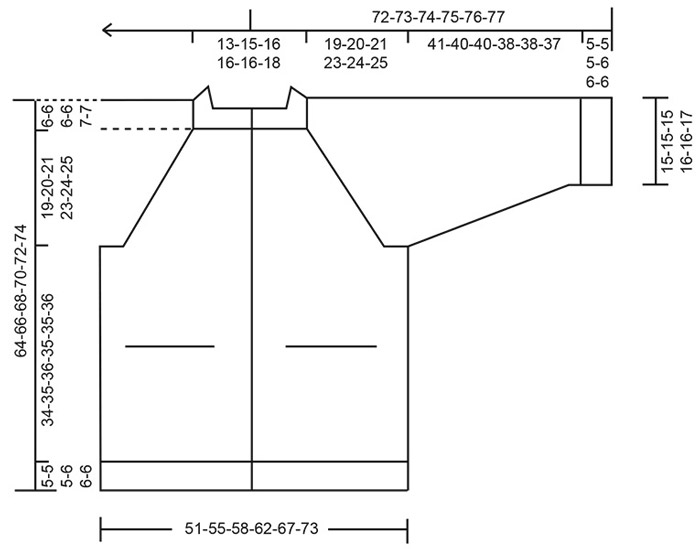 |
|
Have you finished this pattern?Tag your pictures with #dropspattern #blueblisscardigan or submit them to the #dropsfan gallery. Do you need help with this pattern?You'll find 31 tutorial videos, a Comments/Questions area and more by visiting the pattern on garnstudio.com. © 1982-2025 DROPS Design A/S. We reserve all rights. This document, including all its sub-sections, has copyrights. Read more about what you can do with our patterns at the bottom of each pattern on our site. |
|







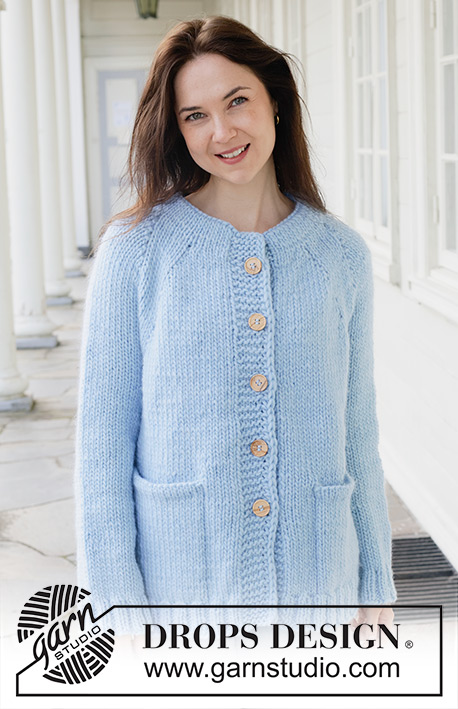
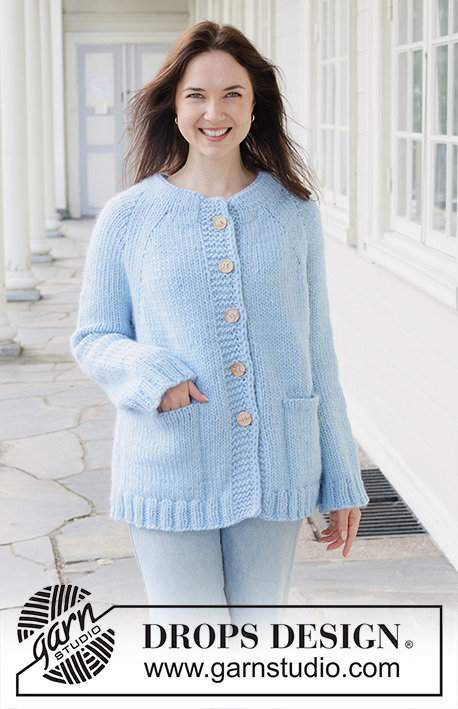
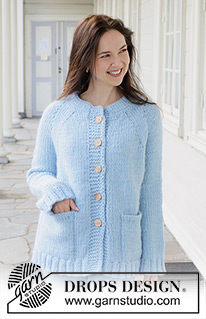
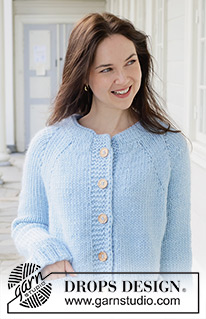
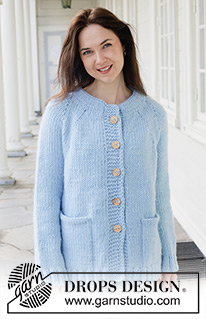

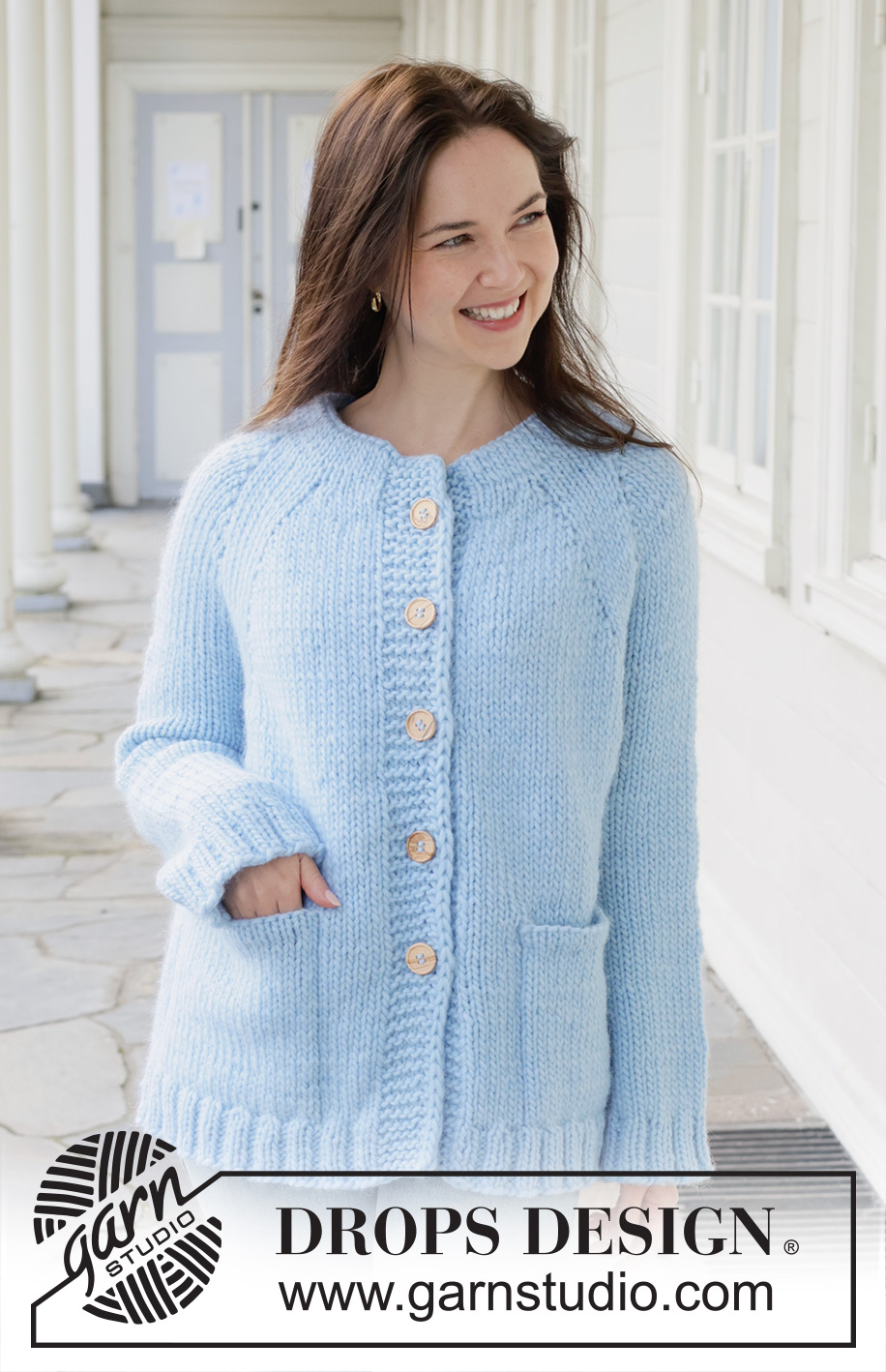
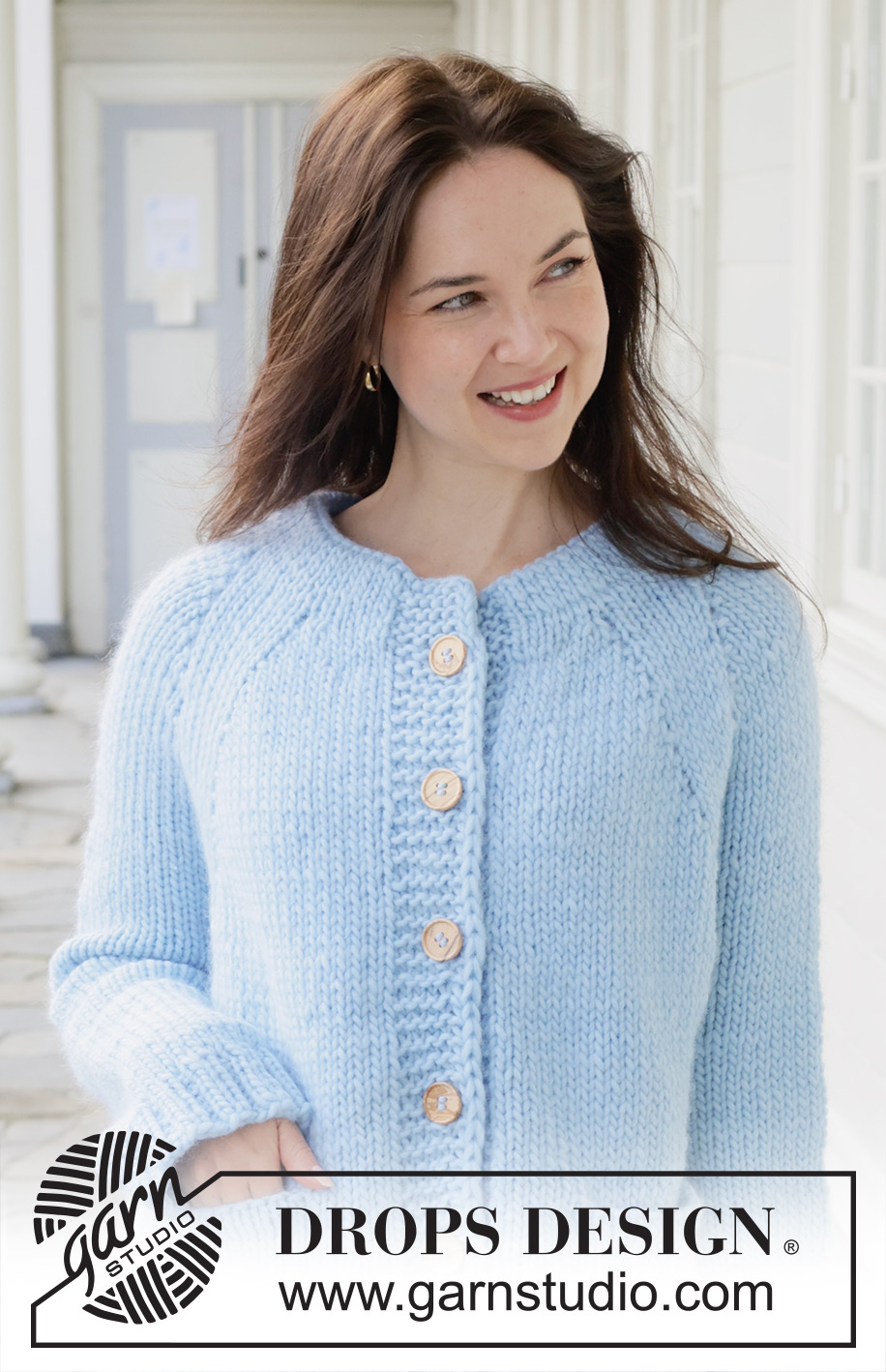
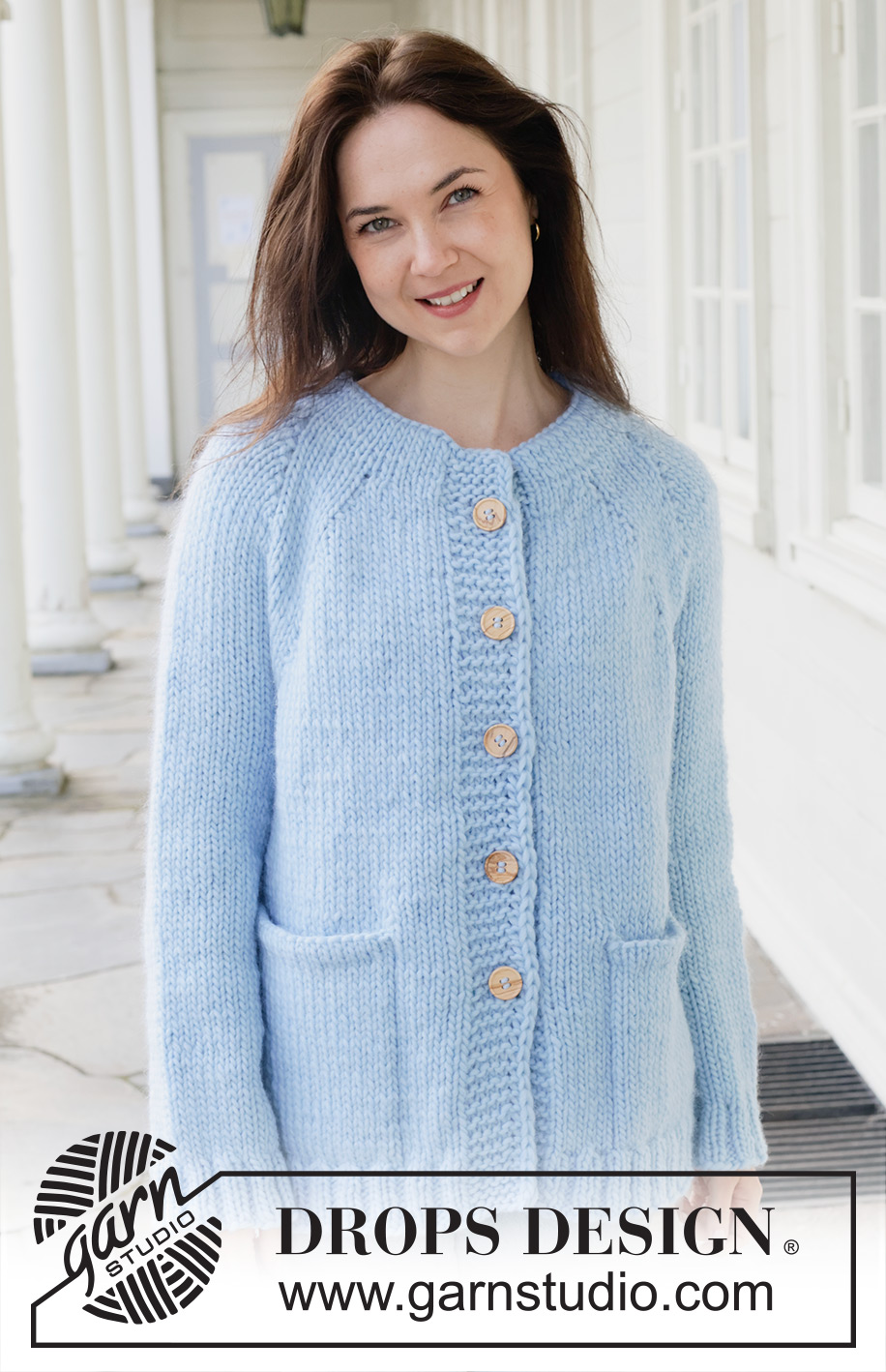
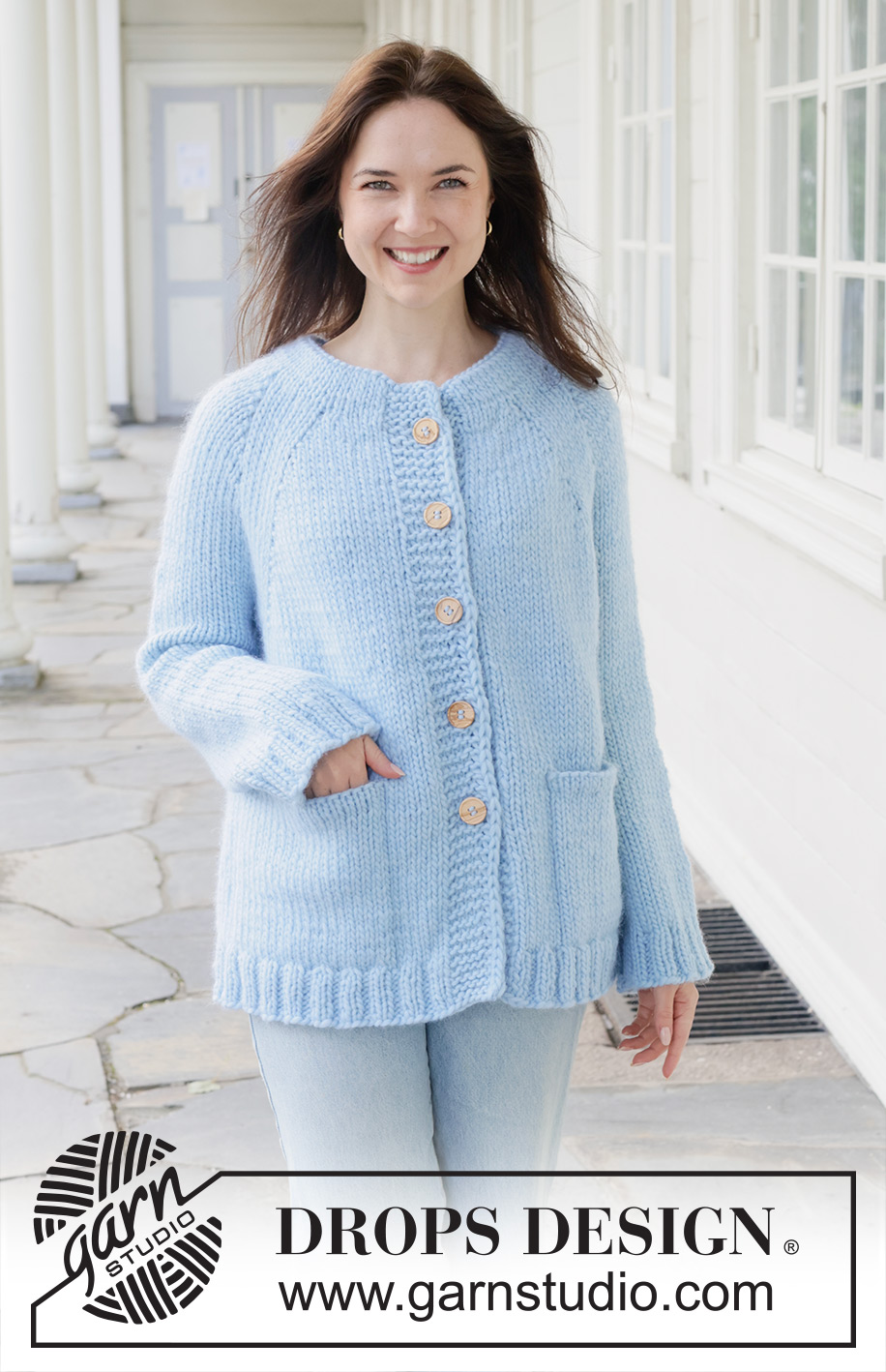

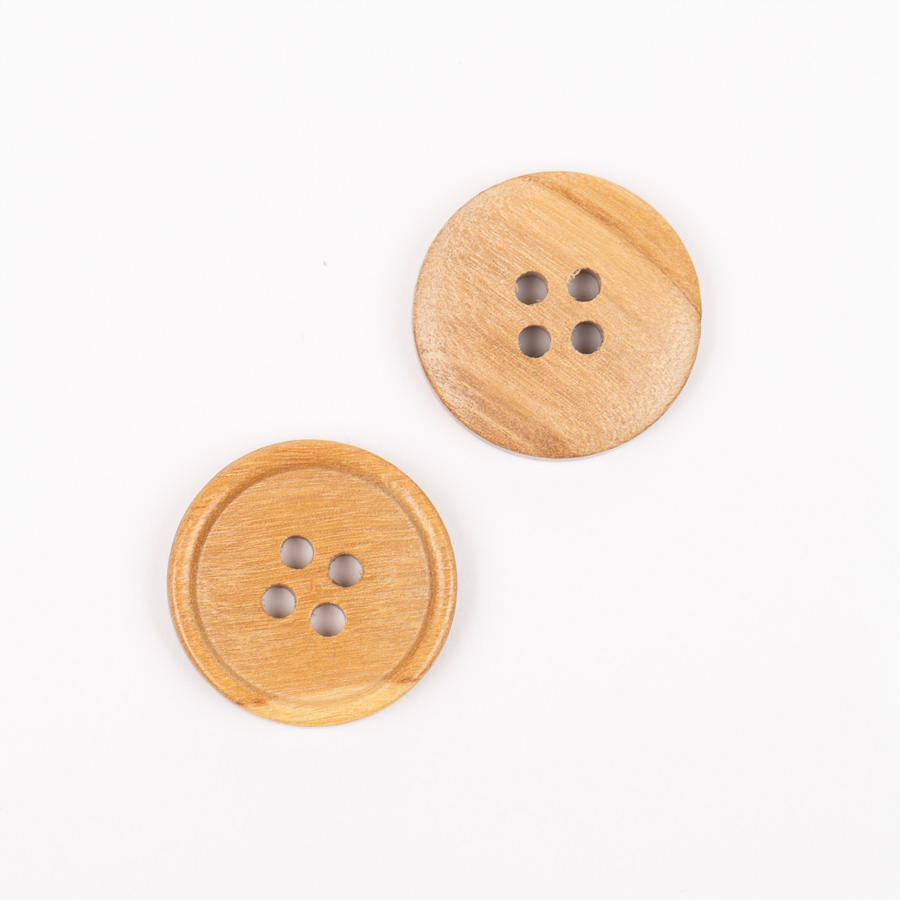

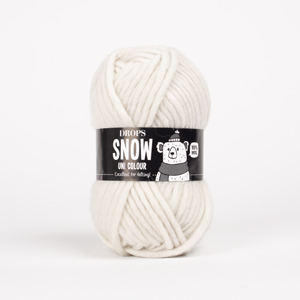
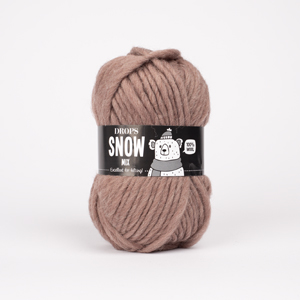


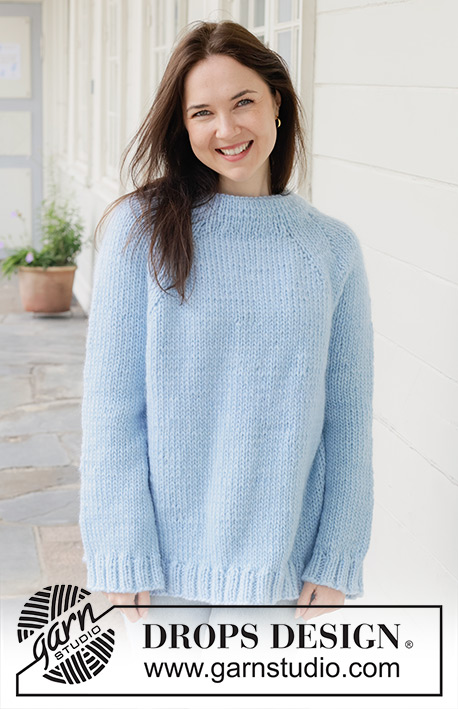
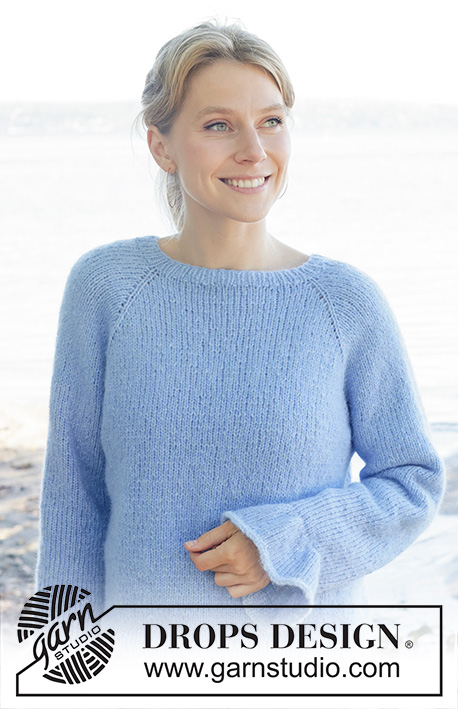






















































Post a comment to pattern DROPS 259-37
We would love to hear what you have to say about this pattern!
If you want to leave a question, please make sure you select the correct category in the form below, to speed up the answering process. Required fields are marked *.